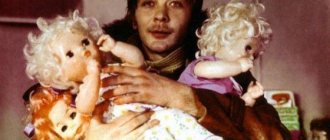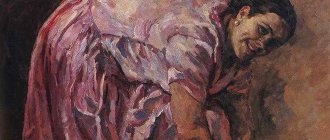Edith Piaf, aka Edith Giovanna Gassion before her twentieth birthday, is a legend of the French stage, and it doesn’t matter what style the Frenchman talking about her considers himself to be. Thanks to her bright voice and incredible talent, this little woman was able to break into the highest echelons of the French elite and forever change both the lives of ordinary Parisians and the concept of the French vocal school. Despite all her merits and the fact that she lived practically without hiding from reporters, not much is known about Edith Piaf herself, mainly only what was difficult to hide or was described in her autobiography or the works of her half-sister Simone Berto , which completed the chronicle of the great singer after her tragic death.
The singer's birth and childhood
Edith's misadventures began almost immediately after her birth on December 19, 1915 - her father, street acrobat Louis Gassion, was at that time away from home, volunteering to fight in the First World War. At the same time, Gassion was given leave to return and see his daughter only on New Year’s Eve, and when he arrived he was horrified - Edith’s mother, a failed actress named Anita Maillard, abandoned her daughter to her mother, going in search of a better fate. The girl’s grandmother was already a very old lady and could not look after the child, so she often ignored the girl’s needs, sometimes even adding wine to her milk so that she would fall asleep faster and not disturb the old woman. Louis, seeing this situation, was going to stay and raise his daughter, but he was not allowed to do so. Then he took the girl to his mother, who ran a small brothel in Normandy and was known as Mama Tina. As it turned out, the decision was brilliant; the girl was looked after not only by the grandmother herself, but also by the prostitutes who surrounded her. Two years later her father returned.
When the girl grew up a little, it turned out that she was blind - it is not known what caused this, but the disease itself was described as reminiscent of keratitis or complicated conjunctivitis. They tried to treat the girl, but all methods known to doctors at that time failed. Then the grandmother decided to take the girl to the grave of Saint Therese of Lisieux, also a very unfortunate, unknown girl, whose creations changed the world. Six days later, Edith regained her sight (however, the scientific point of view explains this by the fact that conjunctivitis as a whole can be defeated by the body without any medications, and a lot of them were poured into Edith). In any case, the girl was able to see, but her eyes remained faded until her death, or, as Piaf’s friend, the poet Jean Cocteau, wrote, “the sun never filled her eyes, they always look like the eyes of a blind man who has just regained his sight.”
Youth
Soon after this, little Edith went to school, but soon left because of her grandmother’s reputation - ordinary French did not want the granddaughter of a woman who ran a brothel to attend school for their children. Then the father took the girl with him to study acting, singing and dancing. At the age of fourteen, she began performing with him - Louis showed magic tricks and acrobatic acts, and Edith sang. She traveled all over France with him and was amazed when her father introduced her to her younger paternal sister, Simone "Momona" Berto, who suddenly began begging Louis to take her with him from her mother, who was raising seven children. Louis was amazed by this attitude towards his daughter and agreed, thus giving Edith a faithful friend, companion and simply a beloved younger sister. Thanks to the girls' talents and the instructions of their father, whose age was already coming to an end, Edith and Momona were able to purchase their own home. Louis stayed with his youngest daughter.
Seventeen-year-old street singer Edith wandered the streets of Paris singing various songs and soon met Louis Dupont, who became her first love. They were not together for long, but soon Edith gave birth to baby Marcel. Louis wanted Edith to quit her job, but she refused and over the next two years Louis did everything to get his daughter back. When Edith was nineteen, Marcelle died of meningitis, which nearly killed Edith herself. After this, the girl swore off ever having children. She will keep her promise.
The beginning of a career: the first songs of Edith Piaf
After the girl turned fourteen, she decided to live an independent life.
At first, Edith worked in a dairy shop, but soon decided to return to street singing. For some time she performed with her younger sister on her father’s side, her name was Simone. They rented a room in a hotel and led a completely independent lifestyle. This existence continued until the owner of the Zhernis cabaret heard her street performance and offered to sing in his establishment. This man's name is Louis Leple. For her first performance, the aspiring singer decided to knit herself a dress, but by the time she went on stage, one sleeve was not knitted. This is precisely the reason why she debuted in a long black dress, throwing a white scarf on top.
Edith Piaf - Padam, Padam From the beginning of Edith's work with Leple, she acquired a pseudonym. Leple named her Edith Piaf. Translated from Parisian argot, the pseudonym was translated as “sparrow.” On the posters it was written – “Baby Piaf”. The girl’s career was rapidly going up, but it was destined to be interrupted due to the tragedy that happened to Leple - he was shot. It so happened that the singer was also suspected of his murder.
Takeoff
Edith's career took a big leap upward on the day when the owner of a local cabaret, Louis Leple, noticed her and, being amazed by her talent, offered her a place on stage. It was he who gave her the pseudonym Piaf - “sparrow” in the slang of Parisian working-class neighborhoods. The fact is that at the time of meeting him, Edith was dressed in old clothes and torn shoes, but continued to walk, singing a song about a cheerful sparrow. Louis taught her the basics of performing on stage and helped her choose her first costume, which became her most famous - a simple black dress, found in storage and which turned out to be exactly the right size. Later, Piaf would always perform in a simple black dress.
It was Leple who helped her hold her first concert, when “baby Piaf” simply blew up the hall, performing on the same stage with many French stars. The audience demanded repetitions and little Piaf performed until she dropped, recording two albums and holding more than thirty concerts in a year. One of the albums was written by Marguerite Monod, who would later become a close friend of Piaf.
However, in 1936, a year after meeting Leple, he tragically died from a bullet in the head. Because he bequeathed a small sum to Edith, the newspapers labeled her a murderer, which led to the downfall of the cabaret. There is a version that Piaf was still to blame for this, but only indirectly - Leple was killed because he refused to give Piaf to competitors who had connections with the underworld. After Leple's death, Piaf hires Raymond Asso, who created a real star out of her, writing songs especially for her that reflect her story, as well as coming up with a new script image.
Biography
Childhood
She was born into the family of failed actress Anita Maillard, who performed on stage under the pseudonym Lina Marsa, and acrobat Louis Gassion. At the beginning of the First World War, he volunteered for the front. He specifically received a two-day vacation at the end of 1915 to see his newborn daughter Edith. According to one version, the future singer received her name in honor of the British nurse Edith Cavell, who was shot by the Germans on October 12, 1915.
Two years later, Louis Gassion learned that his wife had left him and given his daughter to be raised by her parents. The conditions in which little Edith lived were terrifying. The grandmother had no time to take care of the child, and she often poured diluted wine into her granddaughter’s bottle instead of milk so that she would not bother her. Then Louis took his daughter to Normandy to his mother, who ran a brothel.
Childhood photograph of Edith
Then it turned out that three-year-old Edith was completely blind. In addition, it turned out that in the very first months of her life, Edith began to develop keratitis, but her maternal grandmother, apparently, simply did not notice this. When there was no other hope left, Grandma Gassion and her girls took Edith to Lisieux to Saint Therese, where thousands of pilgrims from all over France gather every year. The trip was scheduled for August 19, 1921, and on August 25, 1921, Edith received her sight. She was six years old. The first thing she saw were the piano keys. The great French poet Jean Cocteau, in love with Edith, called them “the eyes of a blind man who has received his sight” [ source not specified 1992 days
].
Soon Edith went to school, surrounded by the care of her loving grandmother, but respectable inhabitants did not want to see a child living in a brothel next to their children, and the girl’s studies ended very quickly. Then the father took Edith to Paris, where they began to work together in the squares: the father showed acrobatic tricks, and his nine-year-old daughter sang. Edith earned money by singing on the street until she was hired at the Juan-les-Pins cabaret. When Edith was fifteen years old, she met her younger half-sister Simone. Simone's mother insisted that her eleven-year-old daughter start bringing money into the house; relationships in the family, where seven other children besides Simone grew up, became difficult, and Edith took her younger sister to sing on the street. Before that, she had already lived independently[7][ unauthorized source?
].
Youth
In 1932, Edith met store owner Louis Dupont; a year later, 17-year-old Edith gave birth to a daughter, Marcelle, on February 11, 1933. However, Louis was not happy that Edith was spending too much time on her work, and he demanded to leave her. Edith refused and they separated. At first, the daughter stayed with her mother, but one day, when she came home, Edith did not find her. Louis Dupont took his daughter to him, hoping that the woman he loved would return to him. Daughter Edith fell ill with tuberculous meningitis and was hospitalized. As a result, Marcel died (July 7, 1935). She was the only child born to Piaf.
In 1935, when Edith was twenty years old, she was noticed on the street by Louis Leplée, the owner of the Gerny's cabaret on the Champs-Elysees, and invited her to perform in his program. He taught her to rehearse with an accompanist, select and direct songs, and explained the enormous importance of an artist’s costume, his gestures, facial expressions, and behavior on stage. It was Leple who found a name for Edith - Piaf (in Parisian slang it means “little sparrow”). In torn shoes, she sang on the street: “Born like a sparrow, lived like a sparrow, died like a sparrow.” In Zhernis, her name was printed on the posters as “Baby Piaf”, and the success of her first performances was enormous. On February 17, 1936, Edith Piaf performed in a big concert at the Medrano circus along with such French pop stars as Maurice Chevalier, Mistenguette, Marie Dubas. A short performance on Radio City allowed her to take the first step towards real fame - listeners called the radio live and demanded that Baby Piaf perform more[8].
However, the successful takeoff was interrupted by tragedy: Louis Leple was soon shot in the head, and Edith Piaf was among the suspects, since he left her a small amount in his will. The newspapers fanned the story, and visitors to the cabaret where Edith Piaf performed behaved hostilely, believing that they had the right to “punish the criminal.”
New takeoff
Soon Edith met the poet Raymond Asso, who finally determined the singer’s future life path. It is he who is largely responsible for the birth of “The Great Edith Piaf”. He taught Edith not only what was directly related to her profession, but also everything that she needed in life: the rules of etiquette, the ability to choose clothes and much more.
Raymond Asso created the “Piaf style”, based on Edith’s individuality, he wrote songs suitable only for her, “made to order”: “Paris - Mediterranean”, “She lived on the Rue Pigalle”, “My Legionnaire”, “Pennant for the Legion” " The music for the song “My Legionnaire” was written by Marguerite Monnot, who also later became not only “her” composer, but also a close friend of the singer. Later, Piaf created several more songs with Monnot, including “Little Marie,” “The Devil Next to Me,” and “Hymn of Love”[8].
It was Raymond Asso who ensured that Edith performed at the ABC music hall on the Grands Boulevards, the most famous music hall in Paris. Performing in “ABC” was considered an entry into the “big water”, an initiation into the profession. He also convinced her to change her stage name "Baby Piaf" to "Edith Piaf". After the success of her performance at ABC, the press wrote about Edith: “Yesterday a great singer was born on the ABC stage in France.”
. An extraordinary voice, true dramatic talent, hard work and stubbornness of a street girl in achieving her goal quickly led Edith to the heights of success.
The Second World War
With the outbreak of World War II, the singer broke up with Raymond Asso. At this time, she met with the famous French director Jean Cocteau, who invited Edith to play in a short play of his own composition, “The Indifferent Handsome Man.” The rehearsals went well and the play was a great success. It was first shown in the 1940 season. Film director Georges Lacombe decided to make a film based on the play. And in 1941, the film “Montmartre on the Seine” was shot, in which Edith received the main role.
Edith's parents died during World War II. Fellow countrymen appreciated both the personal courage of Piaf, who performed during the war in Germany in front of French prisoners of war, so that after the concert, along with autographs, she gave them everything they needed to escape, and her mercy - she organized concerts in favor of the families of the victims. During the occupation, Edith Piaf performed in prisoner-of-war camps in Germany, took photographs with German officers and French prisoners of war “as a souvenir,” and then in Paris, these photographs were used to prepare fake documents for soldiers who escaped from the camp.
Triumph
Edith helped many aspiring performers find themselves and begin their path to success - Yves Montand, the ensemble Companion de la Chanson, Eddie Constantin, Charles Aznavour and other talents.
The post-war period became a period of unprecedented success for her. Residents of the Parisian suburbs and sophisticated art connoisseurs, workers and the future Queen of England listened to her with admiration. At this time, she became close friends with the famous boxer, Frenchman of Algerian origin, world middleweight champion, 33-year-old Marcel Cerdan. In October 1949, Cerdan flew to New York to see Piaf, who was again touring there[8]. The plane crashed over the Atlantic Ocean near the Azores and Cerdan died, which came as a shock to Piaf. In deep depression, she saved herself with morphine.
In January 1950, on the eve of a solo concert in the Pleyel Hall, the press wrote about “songs of the streets in the temple of classical music”
- this was another triumph for the singer.
Despite the love of her listeners, a life completely devoted to song made her lonely. Edith herself understood this well: “The audience pulls you into its arms, opens its heart and absorbs you entirely. You are overwhelmed with her love, and she is filled with yours. Then, in the fading light of the hall, you hear the sound of leaving steps. They are still yours. You no longer shudder with delight, but you feel good. And then the streets, the darkness, your heart gets cold, you’re alone.”
.
At 37, Piaf fell in love again and even married the poet and singer Jacques Pils, but the marriage soon broke up.
In 1952, Edith was involved in two consecutive car accidents, both with Charles Aznavour; To alleviate the suffering caused by broken arms and ribs, doctors gave her morphine injections, and Edith again fell into drug addiction, from which she was cured only after 4 years.
In 1954, Edith Piaf starred in the historical film “The Secrets of Versailles” along with Jean Marais.
Last years
In 1955, Edith began performing at the Olympia concert hall. The success was stunning. After that, she went on an 11-month tour of America, followed by further performances at Olympia and a tour of France. Such physical, and most importantly, emotional stress greatly undermined her health. The functions of the liver were seriously impaired (sclerosis combined with cirrhosis), and the entire body was too weakened. During 1960-1963. she is repeatedly hospitalized, sometimes for several months.
Edith Piaf and Theo Sarapo (1962)
But at the age of 47, Piaf fell in love again, this time with a 27-year-old Greek hairdresser Theo (Theofanis Lamboukas), whom she, like Yves Montana, brought to the stage. Edith came up with the pseudonym Sarapo for him (from the Greek σ 'αγαπώ, “I love you,” if the second consonant is pronounced with a French accent, like “r”). She was with him until her death. Sarapo outlived her by seven years; he died in a car accident.
On September 25, 1962, Edith sang from the height of the Eiffel Tower on the occasion of the premiere of the film “The Longest Day” of the songs “No, I don’t regret anything,” “The Crowd,” “My Lord,” “You Can’t Hear,” “The Right to Love.” All of Paris listened to her.
Her last performance on stage took place on March 31, 1963 at the Lille Opera House.
Edith Piaf's grave at Père Lachaise cemetery
On October 10, 1963, Edith Piaf passed away. The singer's body was transported from the city of Grasse, where she died, to Paris in secrecy, and her death was officially announced in Paris only on October 11, 1963 (which is due to errors in some sources). On the same day, October 11, 1963, Piaf's friend Jean Cocteau passed away. There is an opinion that he died upon learning of Piaf's death.
The singer's funeral took place at the Père Lachaise cemetery. More than forty thousand people gathered at them, many did not hide their tears, there were so many flowers that people were forced to walk right along them.
Career before the war
After his creative and loving union with Raymond Asso, Piaf discovers new heights of creative Olympus. Now she is already an idol throughout France, she is loved and practically idolized, and her concerts attract millions of French people. Piaf plays in the theater, performs at major festivals and makes acquaintances with many famous people of the time, including Maurice Cheval and the poet Jacques Borgo. She also begins to independently write lyrics for her songs, making them more and more touching, which is facilitated by the help of her composer friends - Raymond Asso, with whom she had already broken up, and Marguerite Monnot. She forever associated her fame with the Olympia concert hall, where she performed until her death.
Edith Piaf
- Artists
21/09/2014
Anna Savchenko
176
Edith Piaf is undoubtedly the same star who was destined to burn on the musical horizon for the second century. This small, fragile and childishly naive woman died too early for her memory to fade so quickly.
The little star’s childhood cannot be called happy. It fell during the war years: the mother gave her to her parents, and the grandmother, in turn, supported her granddaughter in the conditions in which she herself lived. The rooms were dirty, smelling of alcohol and poverty.
The girl who unfortunately fell on her grandmother’s head burdened her with constant crying, and in order to calm her granddaughter, the “caring” relative often gave her wine. Edith's father was horrified by such treatment and took the girl with him, but again gave her to her grandmother for care. At the age of three, my grandmother discovered that her beloved granddaughter was blind! And previous relatives didn’t even notice this! The baby was urgently taken to Saint Teresa, where pilgrims gathered in crowds. A miracle happened: Edith received her sight.
As a child, Edith performed with her father: he showed acrobatic acts, and the girl sang. They received quite a decent salary, and Edith soon involved her younger sister in this business.
Edith Piaf photo No. 2
Edith Piaf became a mother early: at the age of seventeen. Constant quarrels with her husband, who did not want his wife to earn a living by singing, led to a quick divorce. As a result, the singer also lost her daughter: one day she did not find the baby at home, and soon it turned out that her father had taken her with him. The father could not keep track of little Marcelle. The meningitis she contracted was a virtually incurable disease, from which she died. Piaf had no more children.
After the tragic event, the singer plunged headlong into work. Edith Piaf's songs quickly found their listeners: radio stations were bombarded with calls from admirers of her voice. Everyone demanded that “Baby Piaf” be played again.
She was helped in many ways by Louis Leple, the owner of a Parisian cabaret, who taught Edith that in show business not only music is important, but also such details as accompaniment, stage name, costumes, makeup and much more. He became Edith's closest friend, for whose murder she was soon accused. Louis died from a shot in the head, and since he bequeathed a certain amount of money to his girlfriend, the press quickly began to create a sensation and accuse the singer of murder.
Piaf became a real lady after meeting Raymond Asso, who opened new horizons for her. He and Marguerite Monnot became the singer’s best friend and girlfriend, and also composers. They saw in her something that others did not see and wrote songs that were uniquely suited to her. Edith Piaf's song "Hymn of Love", which Monnot wrote, does not even need explanation: everything is clear without words.
Edith Piaf photo No. 3
After performing in the best music halls in Paris, no one dared to call Edith a street singer: before their eyes, a new musical legend was being born.
All the singer’s songs are permeated with deep feelings, the most important of which is love. Edith Piaf's song “Rien” is very categorical and tough: the singer sings that she does not regret absolutely anything, because all this is the past that should be forgotten.
During World War II, Edith Piaf's first film, "The Indifferent Handsome," was released. The singer not only played the main role in it, but also wrote the script for the film. During the war, her fellow countrymen’s love for Edith’s work only took root: she gave free concerts, performed in occupied territory, helped prisoners of war in any way she could...
Edith was a truly notable figure: the future Queen of England listened to her, and the singers with whom she sang duets instantly became famous. Unfortunately, the singer was not destined to find personal happiness: the famous boxer, Piaf’s last love, crashed on a plane. She diluted the deep depression into which the star fell with morphine. Edith suffered from loneliness and made another attempt to be happy. At the age of 37 she got married, but the marriage broke up very quickly. It would seem that the problem with morphine use was forgotten, but two accidents that Piaf got into brought fractures and unbearable pain. In order to somehow alleviate the suffering, the singer again got hooked on morphine.
Edith Piaf photo No. 4
At 47 years old, the singer converts to Orthodoxy for the sake of her new boyfriend, who is 20 years younger than her. They got married in church, and a year later Edith died.
Edith Piaf's grave is located in Paris at one of the most famous cemeteries - Père Lachaise. After death, the singer certainly cannot complain of loneliness: crowds of fans come to the grave of their idol every day. During Edith's funeral, such a crowd gathered that there was a stampede! And there were so many flowers that people were forced to walk on them.
One of Edith Piaf's most famous songs, "Padam" is one of the most frequently performed songs in the world: it is covered by both celebrities and aspiring singers. And Edith Piaf’s song “I Don’t Regret” can be called the slogan with which the singer lived her life. Yes, she had her ups and downs, but nothing stopped her or made her despondent. She bravely endured all the hardships and went on stage, from which she always gave warmth to her fans.
In memory of the famous compatriot, Parisians named the square - Place Piaf, which is decorated with a monument erected in honor of the star of French chanson. In addition to her acting and musical career, the singer wrote an autobiographical book. Later, Piaf’s half-sister also released her version of the celebrity’s life. Also named Edith is a small planet discovered in the eighties at the Crimean Observatory by Lyudmila Karachkina.
Whenever a person whom people have recognized as a symbol of an era dies, it seems that the era itself is ending. But that's not true. The most important thing is that Edith Piaf still lives in our hearts, even though almost a hundred years have passed since her birth, and her velvety voice and the energy that she gave from the stage are captured on film and in the memory of those who were lucky enough to see her in person. speeches.
Video for Edith Piaf’s retirement “Non, je ne regrette rien”
Share Tweet Pin It +1
Add a comment Cancel reply
The Second World War
The Second World War almost became a disaster for Piaf, who publicly collaborated with the Nazi regime, but it later turned out that she was almost the best agent of influence of the French Resistance, and her high position under the Aryans (Piaf often performed for high ranks of the German army) deserved she received the status of “one of our own” and the opportunity to take photographs and communicate with French prisoners. It is a known fact that small photographs of prisoners were cut out of one such group photograph and then pasted into false passports. At the next meeting with the same prisoners, Edith handed out passports, which gave them the opportunity to escape without fear of being caught. In this way, Piaf helped save more than fifty people.
After the war, Piaf became a national heroine of France, recording, among other songs, “My Legionnaire” and “Banner for the Legion,” which became symbolic songs for the best unit of the French army.
Triumph
After the end of the Second World War, Edith Piaf's golden time began - she is loved, slightly envied, and she is constantly surrounded by fans, many of whom she brings to the stage, and they turn out to be quite worthy performers. At the same time, Piaf became addicted to morphine, mainly due to the death of boxer Marcel Cerdan, with whom she was hopelessly in love. Later she managed to overcome her addiction, but she returned after a car accident in which Piaf got into with Charles Aznavour - the doctors did not know about her addiction and injected her with morphine.
Movies
| Name | Year | Director | As Edith Piaf | Notes |
| "Piaf" | 1974 | Guy Casaril | Brigitte Ariel | Based on the biography of Edith Piaf |
| "Edith and Marcel" | 1983 | Claude Lelouch | Evelyn Buie | About the love of Edith Piaf and the famous boxer Marcel Cerdan |
| "La Vie En Rose" | 2007 | Olivier Dahan | Marion Cotillard | Based on the biography of Edith Piaf |
Last years
In 1962, Piaf was diagnosed with liver cancer, an incurable disease at that time. She had less than a year to complete her affairs and she spent this year usefully - she sang her favorite songs to Paris from the Eiffel Tower, married Theo Sarapo, whom she again brought into the world and performed for the last time in her favorite concert hall. Olympia,” in which the audience gave her a five-minute standing ovation. However, things got worse and soon, on October 10, 1963, she passed away. Edith Piaf died in her villa near Paris and Theo transported her body to the capital in strict secrecy. Piaf's death was announced the next day and this day became the last for the singer's old friend, hopelessly in love with her, Jean Cocteau. On his grave, according to his will, are written the words “I am still with you.”
Piaf's funeral took place in the form of mass mourning for the singer, and the church refused to celebrate Mass for her because of her wild lifestyle. Piaf was buried by tens of thousands of Parisians, and her grave, where her father and herself lie, became a place of pilgrimage for several generations of Parisians. Theo was buried there after he died in a car accident seven years later. After the singer's death, her autobiography and Simone's book about her were released.









